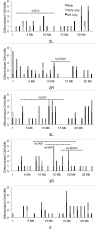Parallel Evolution of Copy-Number Variation across Continents in Drosophila melanogaster
- PMID: 26809315
- PMCID: PMC4909135
- DOI: 10.1093/molbev/msw014
Parallel Evolution of Copy-Number Variation across Continents in Drosophila melanogaster
Abstract
Genetic differentiation across populations that is maintained in the presence of gene flow is a hallmark of spatially varying selection. In Drosophila melanogaster, the latitudinal clines across the eastern coasts of Australia and North America appear to be examples of this type of selection, with recent studies showing that a substantial portion of the D. melanogaster genome exhibits allele frequency differentiation with respect to latitude on both continents. As of yet there has been no genome-wide examination of differentiated copy-number variants (CNVs) in these geographic regions, despite their potential importance for phenotypic variation in Drosophila and other taxa. Here, we present an analysis of geographic variation in CNVs in D. melanogaster. We also present the first genomic analysis of geographic variation for copy-number variation in the sister species, D. simulans, in order to investigate patterns of parallel evolution in these close relatives. In D. melanogaster we find hundreds of CNVs, many of which show parallel patterns of geographic variation on both continents, lending support to the idea that they are influenced by spatially varying selection. These findings support the idea that polymorphic CNVs contribute to local adaptation in D. melanogaster In contrast, we find very few CNVs in D. simulans that are geographically differentiated in parallel on both continents, consistent with earlier work suggesting that clinal patterns are weaker in this species.
Keywords: copy-number variation; natural selection.; population genetics.
© The Author 2016. Published by Oxford University Press on behalf of the Society for Molecular Biology and Evolution. All rights reserved. For permissions, please e-mail: journals.permissions@oup.com.
Figures



References
-
- Agis M, Schlötterer C. 2001. Microsatellite variation in natural Drosophila melanogaster populations from New South Wales (Australia) and Tasmania. Mol Ecol. 10:1197–1205. - PubMed
-
- Aminetzach YT, Macpherson JM, Petrov DA. 2005. Pesticide resistance via transposition-mediated adaptive gene truncation in Drosophila. Science 309:764–767. - PubMed
-
- Arthur A, Weeks A, Sgro C. 2008. Investigating latitudinal clines for life history and stress resistance traits in Drosophila simulans from eastern Australia. J Evol Biol. 21:1470–1479. - PubMed
Publication types
MeSH terms
Grants and funding
LinkOut - more resources
Full Text Sources
Other Literature Sources
Molecular Biology Databases
Research Materials

